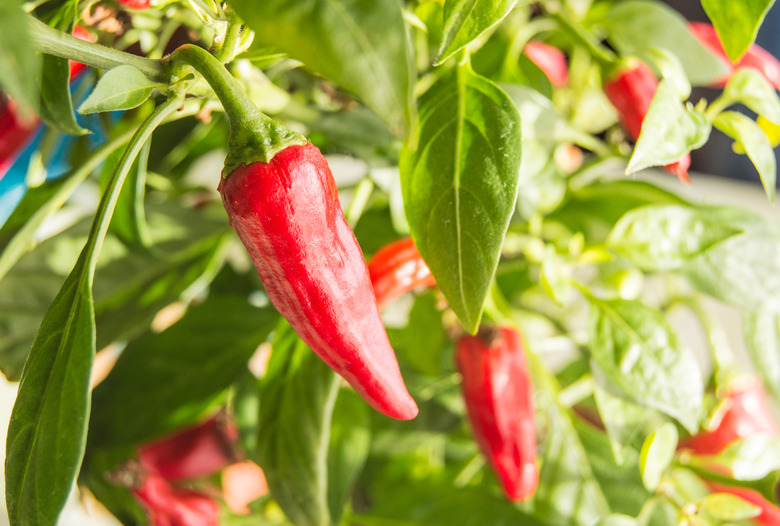How Long Does A Jalapeno Plant Grow?
The tasty fruits of the jalapeno plant (Capsicum annuum) provide flavor and heat to many Southwestern, Mexican, and Central American recipes. When grown as an annual, the jalapeno harvest season is late summer and early fall, though if grown indoors, the plants may continue to flower and produce fruits year-round. Jalapeno chilies, also called jalapeno peppers, are hardy in frost-free gardens in U.S. Department of Agriculture plant hardiness zones 9 through 11.
Tip
On average, a jalapeno plant protected from freezing temperatures will live 18 to 36 months. With care and plenty of sun, water, and fertilizer, a jalapeno plant can live 10 or more years in a warm, sheltered garden or a large container indoors.
Planting Jalapeno Seeds
Jalapenos and other pepper plants are generally started indoors from seeds eight weeks before the last frost date. Fill biodegradable paper or peat pots with moist seed-staring mix. Place the pots on a tray and then press one or two seeds 1/4 inch deep into each pot. Cover with plastic wrap and set the tray on a seed heat mat.
Keep the soil evenly moist and between 80 and 90 degrees Fahrenheit while the seeds germinate, usually within seven to 21 days. When the seedlings appear, remove the plastic wrap and place the pots in bright, filtered light. Place a small oscillating fan near the seedlings to increase air circulation and strengthen the stems.
Transplanting Your Jalapeno Plants
Transplant jalapeno seedlings into the garden after nighttime temperatures rise above 60 degrees Fahrenheit. Harden them off for a week to 10 days, taking them outside into dappled or bright shade for one hour the first day and then gradually adding an hour and moving toward direct sun every day until the plants are in full sun all day. Leave them outside overnight and then transplant the following morning while the air is still cool and the soil is moist.
Remove plant debris, sticks, and rocks, and then dig 2 to 3 inches of compost into a sunny, well-drained garden bed. Water thoroughly the night before you plant the jalapeno seedlings. In the morning, tear off the top one-third of the paper or peat pot. Plant the jalapeno plants at the same depth with the remainder of the biodegradable pot completely covered by the soil, spacing the plants 3 feet apart.
If planting into containers, use 12- to 15-inch-wide pots to avoid transplanting later. Fill the container with a good-quality potting soil or a mix of equal parts compost, peat moss or coconut coir, and coarse sand or perlite. Water, transplant the seedlings, and then water again. Place them in direct sunlight or bright filtered light with a grow light suspended a few inches above the foliage.
Caring for Jalapeno Plants
Keep the soil evenly moist, applying at least 1 to 2 inches of water weekly. Container plants may need daily watering in hot weather; water when the soil is dry to a depth of 1 to 2 inches. Use a soaker hose or hose end bubbler to avoid wetting the foliage, flowers, and developing peppers. Add a 2- to-3-inch layer of mulch over the soil, pulling it back 3 to 4 inches from the stems.
If your soil is poor, add a 10-10-10 slow-release fertilizer before transplanting your jalapeno plants into the garden. Side-dress with a few shovelfuls of compost when the first fruits appear. As the plants grow and the fruits develop, fertilize with a balanced 10-10-10 fertilizer or biweekly with 1 cup of compost tea per plant. Always water thoroughly after fertilizing.
Determining the Jalapeno Harvest Season
Harvest your jalapenos approximately 70 to 80 days after transplanting the seedlings into the garden or container. The chilies turn from light to dark green and range from 2 to 4 inches long depending on the cultivar. Put on gloves and safety glasses and use sterilized pruners when snipping the jalapenos from the plant. You can also allow the jalapenos to fully ripen and turn yellow, orange, or red.
If frost threatens, move container plants indoors to a brightly lit window and add a grow light to ensure they receive enough light. Outdoor plants can be protected at least temporarily with frost blankets or plastic sheeting supported by stakes.
